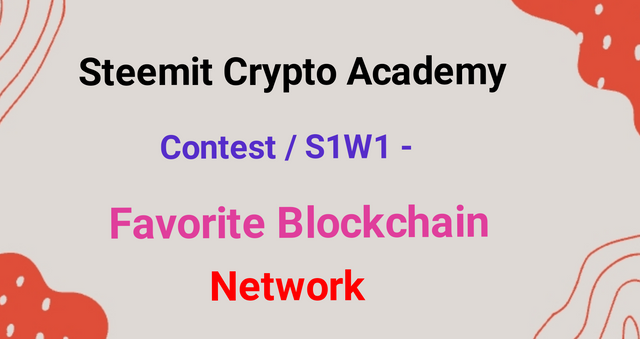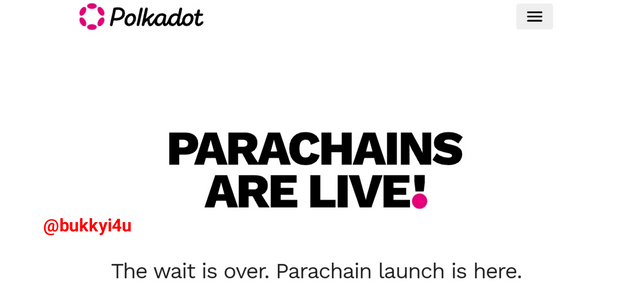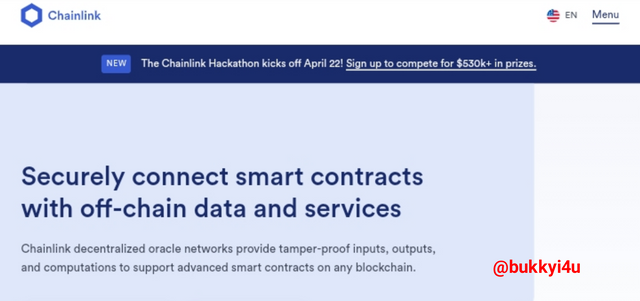
Edited with imarkup

Hello everyone it is nice being part of the Steemit Engagement Challenge. I wish to begin my entry this week in the Steemit Crypto Academy. I wish to discuss the Polkadot (Dot) blockchain which is my favourite in this entry.

Tell us about your favourite Blockchain network, its history, and

The Polkadot Ecosystem was designed to work as a type of software that would provide incentive to a network of computers connected globally which are designed to operate in the blockchain from where other users may be able to operate and launch their personal or self-styled blockchain projects.
The Polkadot ecosystem was released in 2020 and this makes it one of the newest with a whole lot of new and important technical features. The network works in a manner that makes it possible for two different types to operate on it. These would include the main network usually referred to as the relay chain that enables transactions that are permanently stored. The order comes in the form of a network of parachains that can be created by users.
The parachains are customisable and can be made to suit any type of uses while being able to feed into the main chain. This makes it possible for transactions that are carried out on the parachain to possess the benefit of the larger form of security that is obtainable from the main chain. In this way, the computing resources needed to run only the main chain can arguably be used to extend accuracy and security to transactions being carried out on the parachains.
Gavin Wood who is known to be a co-founder of the Ethereum Network is equally credited to have founded the Polkadot Ecosystem. He founded the blockchain together with Robert Habermeier and Peter Czaban in 2016. In 2015, Wood was known to have founded, together with Jutta Steiner, Parity Technologies. This was meant to be used for the implementation of projects on the Ethereum Network but now equally serves as a substrate which enables Polkadot users to create parachains much more quickly.

Why is it your favourite?
I adopted the Polkadot Blockchain as my favourite after I discovered the interesting architecture upon which it is built and made to function. I am going to describe a few of these interesting features and architecture which constitutes the structure of the network that has attracted me to it.
These features determine how the network works are described below. To start with, it is possible to create three different types of blockchains on the Polkadot Network, namely:-
The Relay Chain:- This serves as the main blockchain from which transactions can be finally transmitted. Its unique model which separates validation of transactions from addition of transactions makes the system able to perform over 1000 transactions in a second.
Parachains:- The computing resources of the relay chain can be used by customised blockchains on the main network in the confirmation of transactions on the parachains which are created as custom blockchains.
Bridges:- The use of bridges makes it possible for interactions to occur between other blockchains and the Polkadot Ecosystem. There is the goal of developing Bridges to connect Ethereum, EOS, Cosmos and the Bitcoin networks for easier swapping of tokens without the need for any central exchange.
Furthermore, the re chain makes use of Nominated-proof-of-stake (NPoS) where it is possible to stake the Dot token in order to gain a chance of being able to perform any of the following functions:-
- Validators who take part in consensus and validate data while equally contributing to new changes with their votes.
- Nominators whose work is to select validators who are trustworthy as a way of securing the relay chain. Usually, they delegate their Dot tokens which are staked.
- Collators which function as nodes for the storage of parachains transaction history and packaging of data to be added to the relay chains.
- The fishermen who have the work of monitoring and reporting wrong behaviours if observed on the part of the validators.

Does the network have some earliest shortcomings and how has the network's team taken care of the problem?


Source
The historic problem that had been suffered by the Polkadot Network is the Free Rider Problem which usually came up in the process of allocating slots to parachains. Various parachain networks are connected in the Polkadot ecosystem with the use of the Relay Chain. Due to limited support on the Relay Chain, a system of on-chain auction is used in the allocation of parachain slots.
This means that the teams behind the parachains must lock up the polkadot native token in order to successfully lease a slot. This created the Free Rider Problem. This problem means that communal services and resources can be accessed by some users when they have not actually paid for such. Normally, this problem arises when the network is abridged to another.
In order to solve this problem, the team behind the ecosystem introduced public utility chains as well as system-level chains. With the use of system level chains functionality can be moved into the parachains from the relay chains. This reduces the use of the relay chain for administrative purposes while equally improving their efficiency.
The public utility chains can function as generic asset chains, bridges and smart contract platforms. They are used in the addition of functionalities to the network. However, they are made to remain aligned with the stakeholder base of the relay chain. In this way, the free rider problem was solved by the polkadot team.

What changes do you think would make the network better?

As much as the Polkadot blockchain comes with quite tremendous benefits there are still several areas where improvements are needed in order to make the network better. Some of these areas I would like to see improved include:-
The network must develop a stronger capacity to withstand negative attacks as we can readily remember back in 2017 when a group of hackers were able to take out $33 million as a result of software flaw leading to the compromise of the team's wallet even for a second time
It has been observed that it is quite expensive for non-commercial users as well as startups to afford making initial investment with the native token of the Polkadot Ecosystem which is the Dot token. This shouldn't be so considering the fact that smart contract companies now face a lot of competition in the market.
Slots have also been observed to be in a limited number of supply thereby making it potentially difficult or impossible for some small use cases or users to be able to obtain them in the slot auctioning process.
A very huge amount of liquidity cannot be filled for the Dot token due to the fact that it is relatively new, although it is among the top 10 by market capitalization. Hence, the needed infrastructure should be created to make such liquidity available. This can include looking into innovative technologies that can make this possible.
In the auctioning of slots for parachains, the period of time for which funds are required to be locked up is quite long. I believe that working on reducing this lengthy time factor would do more good than harm to the system

Write about a Project that is built on your favourite Blockchain


Source
The Chainlink protocol is a project developed on the parachain of the Polkadot platform. It was created with the intention of being used as a tool to bridge the gap between blockchain and legacy technology in terms of interaction. The fact that the blockchain technology is yet unable to make use of data from the real world to leverage its operations necessitates the birth of this protocol.
Co-founded in 2017 by Sergey Nazarov and Steve Ellis, it is majorly intended to be used in creating a safe and secure procedure for data from the real world to be linked to blockchain, hence, it is called an Oracle. So, with the Chainlink Network, use can be made of nodes in assessing data from the real world and transmitting the same to a smart contract hosted on a blockchain.
Some of the real life applications and important functionalities of the protocol include:-
- Lack Of A Recognisable Single Point Of Failure: The network is not managed in a centralised form. There is a network of oracles and this means that even if one malfunctions dearest wouldn't be affected.
- Leveraging Mainstream Data For Blockchain Technology: The protocol has the ability to translate data from blockchain into a format that can be easily recognised off the blockchain.
- Better Security For Transactions: Transactions are given more security on the Chainlink protocol due to the presence of a reputation system which also comes with reward of nodes to maintain the most acceptable results in terms of security and accurate information.
Furthermore, there are a lot of interesting use cases that make the Chainlink protocol worthwhile. Some of these use cases include:-
1- Providing network of oracles that are trustworthy in DeFi ecosystems
Use can be made of Chainlink Price Feeds to obtain critical data from financial markets for smart contracts or projects that are based on DeFi ecosystems
2- Acting as a connector for smart contracts
With the use of oracle's that are very secure the network is able to connect smart contracts with real-world data thereby making payments, price feeds, events, sports data, medical data that are to be computed off-chain to be readily available to blockchain smart contracts.
3- Providing randomness for blockchain
Randomness is needed in such areas as NFT minting, powering of gameplay scenarios that are to be made unpredictable and for randomly distributing rewards. The Chainlink VRF makes this a possibility in the blockchain industry.
These are some of the interesting benefits and description of the ChainLink Protocol which is built and integrated into the Polkadot ecosystem.

CONCLUSION

It is very obvious that the Polkadot project is a huge one and has a team of strongly talented developers. Just like every other blockchain there are areas of limitation which I would want the team to resolve or improve in the nearest future. That said, it is necessary to understand that even in its early stage it has brought some working solutions to the blockchain which is helping to fastrack mainstream adoption of a lot of blockchain use cases.
There are a lot of interesting projects on the Polkadot Ecosystem. The Chainlink Project happens to be one of them. With the use of the Substrate technology the two networks have been integrated. The Chainlink is important in the Polkadot Network because it helps to provide oracle based services through the Substrate system to the polkadot network.

I enjoyed reading through your description of the Polkadot ecosystem. Equally, I like your choice of the ChainLink oracle. Keep it up.
Downvoting a post can decrease pending rewards and make it less visible. Common reasons:
Submit
Wow, I love your description of your favourite Blockchain, really the Polk is a well planned Defi system.
Downvoting a post can decrease pending rewards and make it less visible. Common reasons:
Submit
Hi @bukkyi4u,
Thank you for participating in this contest.You actually did a proper research on Polkadot network.Its consensus algorithm is new to me -NPoS where some nodes are nominated to validate transactions and they are monitored and reported for any wrong doings.
Chainlink is great as it will aid interaction between real world and blockchain.Thats fantastic.
Downvoting a post can decrease pending rewards and make it less visible. Common reasons:
Submit
That's wonderful, I recommend this article for polkadot, well explain...
Downvoting a post can decrease pending rewards and make it less visible. Common reasons:
Submit
Beautiful project you have explained here. The polkadot is a very solid project with advantages too many. I am much in love with this project because it acts as a connector for smart contracts. Also it is above the $10 mark. Very good coin and also a good analysis.
Downvoting a post can decrease pending rewards and make it less visible. Common reasons:
Submit